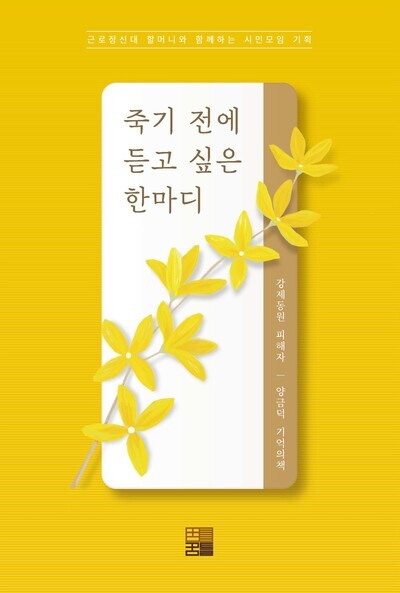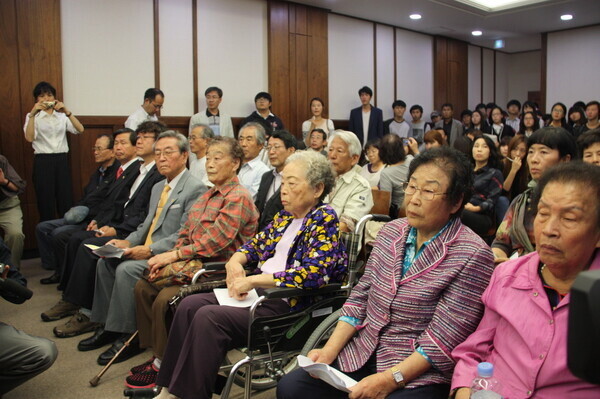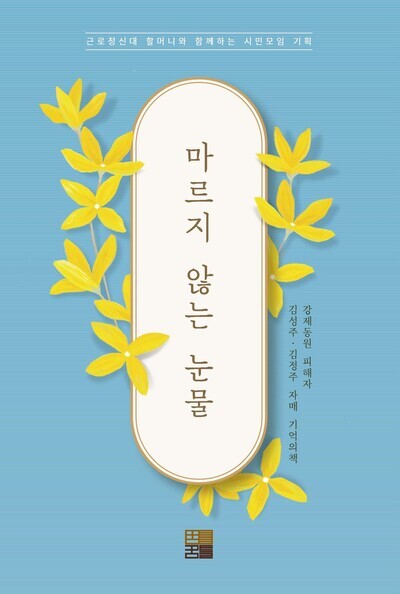hankyoreh
Links to other country sites 다른 나라 사이트 링크
Forced labor survivor publishes autobiography, laments lack of apology from Japan

“It’s gratifying. I’m happy. To have my book coming out at 92 years old makes me feel like I haven’t lived my life in vain.”
Yang Geum-deok, 92, a survivor of forced labor under the Korean Women's Volunteer Labor Corps during the Japanese occupation — said on Jan. 19 that she wanted to “thank the people for remembering.”
The group Citizens’ Forum for Halmuni (meaning “grandmothers” or “elderly women”) recently published Yang’s autobiography under the title “What I Want to Hear Before I Die” (Dream Matrix Publishing). As Yang went back through her memory and shared her account, the forum compiled her recollections into a 175-page book.
A native of Naju, South Jeolla Province, Yang decided to travel to Japan in May 1944 after being misled by her Japanese headmaster’s claim that she would be admitted to junior high school if she went. Named as her class president thanks to her strong academic and athletic performance, she wanted to attend an advanced school in Japan. But her father became enraged when she told him. The next day, she told her teacher she would not be going. In response, she was told that if she did not go after being designated, her mother and father would be taken to jail. Terrified, she “secretly took my father’s official seal from the shelf and gave it to my teacher,” she writes.

From there, Yang traveled to Japan as a labor corps member. The “labor corps” was in reality a group of minors, young women aged 13 to 15, who were mobilized to work at three munitions factories in imperial Japan, including one belonging to Mitsubishi Heavy Industries, in the later stages of the Pacific War in 1944–45. A total of 228 girls were taken, including 138 from the Honam region and 150 from Chungcheong.
Sent to work at a Mitsubishi Heavy Industries aircraft factory in Nagoya, Yang lived through the Tonankai Earthquake there on Dec. 7, 1944. The difference between life and death came down to just 10 minutes: “Choi Jeong-rye, an older friend of mine from Naju who had taken her break 10 minutes ahead of me, and a friend the same age named Kim Hyang-nam were killed where they stood, crushed by a fallen wall.” The incident left her with trauma that has lasted throughout her life. Six young women in their teens from Gwangju and South Jeolla lost their lives in the quake. Yang herself became trapped in the crevice of a fallen wall, but was ultimately rescued. “My left shoulder was injured at the time, and I still have aches and pains today,” she said.

While she was finally able to return home in October 1945 after Korea’s liberation, she never received any pay from Mitsubishi for her intensive labor.
“The Japanese told me, ‘We know your address in your hometown. We’ll send you your pay there.’ But it was all lies,” she recalled.
More misfortune befell her after her return. Marriage offers dried up, as others mistakenly believed she had been working as a sexual slave, or “comfort woman,” for the Japanese military. Indeed, many of the surviving members suffered divorce and other upheavals in their lives after coming home because the “labor corps” was misconstrued as being the same as the comfort women system of sexual slavery. Yang did finally marry a man introduced to her by her second sister, but he separated from her not long after because he falsely believed she had been a comfort woman. “Ten years later, he returned, sick and with three sons in tow,” she recalled. He passed away shortly thereafter. Yang moved to Gwangju, where she made a living selling croakers at Daein Market.
“Even today, I’m convinced there’s nobody who can string croakers more beautifully than me,” she said.
“I was going to starve if I didn’t work, so I kept working, never taking a single day off as I put my six siblings through school and married them off,” she added.
It was around 1992 that she began taking legal action to demand compensation from Mitsubishi Heavy Industries. Hearing that a Japanese man named Makoto Takahashi was looking for “people who were forcibly mobilized to work at Mitsubishi factories,” Yang decided to share the history she had been concealing over the years. The first lawsuit was initiated in a Japanese court in February 1992, but all of the cases ended in defeat, and in 2013 Yang filed suit in the Gwangju District Court. A final victory came in the Supreme Court in November 2018, but she has yet to receive an apology or compensation as the Japanese government continues to thwart the process.
“All I ask is just for them to say, ‘We’re sorry,’” she said. “If they would just say, ‘We apologize, please just live out your life in good health,’ that would be enough. It just makes me boil inside.”
“I hope to fight alongside conscientious people in Japan until the apology and compensation come,” she added.

At the same time, Yang’s attitude on history is optimistic. “Even if the Japanese government won’t offer a word of apology, it gives me strength when Gwangju citizens and high school students come to me to hear about history, offer me comfort, and wish me good health,” she said.
The Citizen’s Forum for Halmuni has also published another autobiography titled “Undried Tears,” which tells of the lives of two sisters and labor corps survivors Kim Seong-ju, 92, and Kim Jeong-ju, 90. In June 1944, Kim Seong-ju was taken to work at Mitsubishi Heavy Industries after graduating from Suncheon South Elementary School. Her younger sister went to work for Fujikoshi just ahead of her own elementary school graduation ceremony in February 1945 when she was told she’d be able to see her sister if she went. In 2019, Kim Jeong-ju won her case in the Seoul High Court requesting damage from Fujikoshi; she is currently awaiting a final decision by the Supreme Court.
The 10 million won (US$9,095) in publication costs for the two autobiographies was paid for with direct donations from 564 people and a crowdfund of 9,384 donors organized by the Beautiful Foundation and Kakao Together. Another 300,000 yen (US$2,892) was provided by the Japanese civic group Nagoya Lawsuit Support Association.
By Jung Dae-ha, staff reporter
Please direct comments or questions to [english@hani.co.kr]

Editorial・opinion
![[Column] The state is back — but is it in business? [Column] The state is back — but is it in business?](https://flexible.img.hani.co.kr/flexible/normal/500/300/imgdb/original/2024/0506/8217149564092725.jpg) [Column] The state is back — but is it in business?
[Column] The state is back — but is it in business?![[Column] Life on our Trisolaris [Column] Life on our Trisolaris](https://flexible.img.hani.co.kr/flexible/normal/500/300/imgdb/original/2024/0505/4817148682278544.jpg) [Column] Life on our Trisolaris
[Column] Life on our Trisolaris- [Editorial] Penalties for airing allegations against Korea’s first lady endanger free press
- [Editorial] Yoon must halt procurement of SM-3 interceptor missiles
- [Guest essay] Maybe Korea’s rapid population decline is an opportunity, not a crisis
- [Column] Can Yoon steer diplomacy with Russia, China back on track?
- [Column] Season 2 of special prosecutor probe may be coming to Korea soon
- [Column] Park Geun-hye déjà vu in Yoon Suk-yeol
- [Editorial] New weight of N. Korea’s nuclear threats makes dialogue all the more urgent
- [Guest essay] The real reason Korea’s new right wants to dub Rhee a founding father
Most viewed articles
- 1[Column] Why Korea’s hard right is fated to lose
- 2Amid US-China clash, Korea must remember its failures in the 19th century, advises scholar
- 360% of young Koreans see no need to have kids after marriage
- 4[Column] The state is back — but is it in business?
- 5Hybe-Ador dispute shines light on pervasive issues behind K-pop’s tidy facade
- 6[Column] Can Yoon steer diplomacy with Russia, China back on track?
- 7Inside the law for a special counsel probe over a Korean Marine’s death
- 8Japan says it’s not pressuring Naver to sell Line, but Korean insiders say otherwise
- 9[Editorial] Penalties for airing allegations against Korea’s first lady endanger free press
- 10Presidential office warns of veto in response to opposition passing special counsel probe act